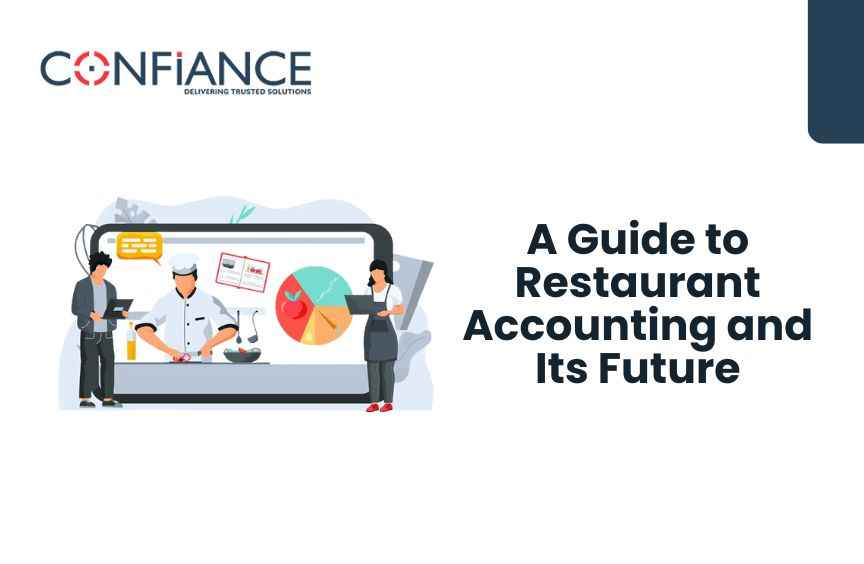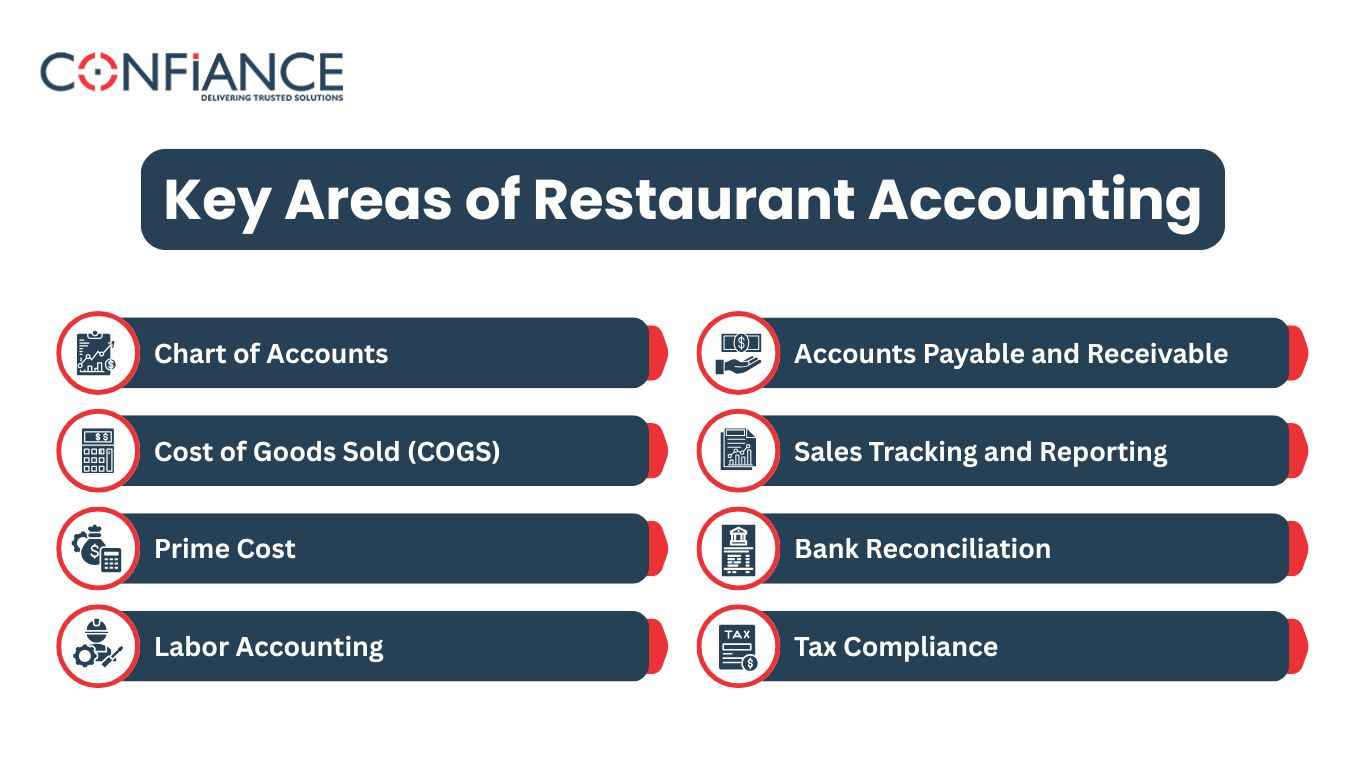
A Guide to Restaurant Accounting and Its Future
Running a restaurant takes more than great food and friendly service. Without clear financial records, a restaurant can lose track of costs, waste resources, or miss tax deadlines. That is where restaurant accounting becomes essential. This blog breaks down what restaurant accounting involves, why it matters, and how it is changing with time.
What Is Restaurant Accounting
Restaurant accounting is the process of tracking income, expenses, assets, and liabilities in a restaurant. It helps owners see how much they earn, what they spend, and where they stand financially.
It differs from general accounting because restaurants deal with high inventory turnover, fluctuating food costs, tipped wages, and complex sales data. Managing this information takes specific methods and tools.
Why Restaurant Accounting Matters
Restaurants often operate with narrow margins. Mistakes in accounting can quickly lead to cash flow issues or tax trouble.
Good accounting helps with:
- Daily cost control
- Weekly profit reviews
- Monthly financial reporting
- Budgeting and forecasting
- Payroll and tax filings
- Loan or investor reports
Restaurants with clear records know when to cut costs, raise prices, or scale operations. It keeps them prepared for audits and more stable during slow periods.
Key Areas of Restaurant Accounting
1. Chart of Accounts
A chart of accounts is a list of categories used to record financial activity. It separates income, food costs, labor, operating expenses, and other data into clear sections.
A typical chart of accounts for a restaurant includes:
- Revenue (food sales, drinks, events)
- Cost of goods sold (food, beverages)
- Labor (wages, tips, payroll taxes)
- Operating expenses (rent, supplies, utilities)
- Marketing and promotion
- Depreciation and interest
- Taxes
Using a tailored chart of accounts helps restaurants see which areas need attention.
2. Cost of Goods Sold (COGS)
COGS is the total cost of food and drinks used to make what was sold. It includes ingredients, packaging, and spoilage.
Formula:
Beginning inventory + Purchases – Ending inventory = COGS
A high COGS means food is wasted, stolen, or priced too low. It should be tracked weekly or even daily in high-volume spots.
3. Prime Cost
Prime cost is the sum of labor and COGS. These are the two biggest expenses in restaurants.
Formula:
COGS + Labor = Prime Cost
Keeping prime cost between 55 to 65 percent of total sales is considered healthy. If it goes higher, the restaurant may not be profitable.
4. Labor Accounting
Restaurants have hourly, salaried, and tipped employees. Tracking hours, tips, overtime, and payroll taxes is crucial.
Labor laws require accurate records. Missed payments or incorrect withholdings can lead to fines. Automated payroll systems reduce errors and save time.

5. Accounts Payable and Receivable
Restaurants pay vendors for food, supplies, and services. These payments fall under accounts payable. Keeping track of due dates prevents late fees and preserves relationships.
Some restaurants also offer catering or event services. These often involve invoices. Tracking accounts receivable ensures payments are collected on time.
6. Sales Tracking and Reporting
Sales come from food, drinks, delivery, takeout, and events. Most restaurants use point of sale systems to track this data.
Daily reports help spot patterns. Weekly summaries allow for cost comparisons. Monthly statements guide budgeting and long-term planning.
7. Bank Reconciliation
Bank reconciliation compares the restaurant’s records to actual bank statements. It ensures no errors or unauthorized charges go unnoticed.
Doing this monthly helps prevent fraud and catch accounting mistakes early.
8. Tax Compliance
Restaurants handle multiple taxes. These include:
- Sales tax
- Payroll tax
- Income tax
- Liquor tax (if applicable)
Mistakes in filings can lead to penalties. Proper records make it easier to file accurately and respond to audits.
Common Reports in Restaurant Accounting
Profit and Loss Statement
Shows income, costs, and net profit over a set time. It highlights whether the restaurant is earning more than it spends.
Balance Sheet
Shows assets, liabilities, and equity. It helps assess financial health and long-term risk.
Cash Flow Statement
Tracks cash entering and leaving the business. It explains how operations, investments, and financing affect liquidity.
Daily Sales Report
Breaks down daily revenue, covers (guests served), and average ticket size. Managers use it to make quick decisions.
Tools for Restaurant Accounting
Using the right software saves time and improves accuracy. Many restaurants use systems like:
- QuickBooks (with restaurant templates)
- Xero
- Restaurant365
- MarginEdge
- Toast (for POS and basic reports)
These platforms can track sales, sync with bank accounts, manage inventory, and automate payroll.
Some tools even integrate with reservation systems or delivery platforms. This creates one source for all financial data.
Bookkeeping Tips for Restaurants
Use accrual accounting
Accrual accounting records income and expenses when they occur, not when money changes hands. It gives a clearer view of profit.
Do weekly check-ins
Waiting until month end is too late. Review COGS, labor, and sales weekly to catch problems early.
Track tips correctly
Tips are taxable income. Track employee-reported tips and ensure proper tax reporting.
Monitor vendor payments
Review invoices before payment. Look for price changes or added fees.
Review financials monthly
Compare this month to last month. Compare this year to last year. Watch for slow growth or rising costs.
Common Mistakes in Restaurant Accounting
- Mixing personal and business expenses
- Ignoring unpaid invoices
- Not counting spoiled or wasted food
- Failing to track petty cash
- Overlooking small fees and charges
- Filing taxes late or without backup
These mistakes can shrink profit and invite audits. Regular reviews and clear rules prevent most of them.
The Future of Restaurant Accounting
Restaurant accounting is changing with new tools and trends. Manual entry is fading. Automation and real-time insights are taking over.
Cloud Accounting
Cloud-based platforms let owners view numbers anytime from any device. They sync with POS systems, bank accounts, and payroll.
This cuts down on paperwork and keeps data up to date.
AI and Automation
New systems use artificial intelligence to detect spending patterns, send reminders, and even suggest price changes.
Invoices can be scanned and logged automatically. Reports can be generated in seconds.
Data Integration
Point of sale, inventory, and payroll systems are now linked. This gives a complete view of the business. Owners can see how menu changes affect profit or how staffing changes affect labor cost.
Outsourced Accounting
Many restaurants now outsource accounting to firms that specialize in food service. This lowers the need for in-house staff and gives access to expert support.
Better Forecasting
New tools help predict busy days, plan menus, and adjust staffing. They rely on sales history, weather data, and holidays to give smart estimates.
More Focus on Compliance
Rules for taxes, tips, and labor reporting are getting stricter. Restaurants that use outdated systems may struggle to keep up.
Automated systems are better at tracking these items and keeping records ready for audits.
Restaurant accounting is not just about recordkeeping. It is about understanding how money moves through the business. It gives owners control, helps spot waste, and prepares them for future growth.
By using modern tools and following basic methods, restaurant owners can stay ahead. They do not need to be experts. They need clear records, smart systems, and good habits. If you are unable to manage it yourself, you outsource it to Confiance. We have years of experience as restaurant accounting is our core expertise. Contact us now and get started with our restaurant accounting services.
The future of restaurant accounting is faster, more connected, and easier to manage than ever before.
FAQs
- What makes restaurant accounting different from other businesses?
It includes tipped wages, high inventory turnover, and many small transactions. It needs more frequent tracking and specialized tools.
- How often should I check my restaurant’s financials?
Check daily sales and weekly costs. Review monthly reports in detail to spot trends and plan ahead.
- Can I use regular accounting software for a restaurant?
Yes, but using software designed for restaurants is better. It tracks food costs, tips, and sales more accurately.
- What is the best way to track food costs?
Use the COGS formula. Count inventory weekly, log purchases, and compare it to sales. This shows how much was spent making sold items.
- Should I hire an accountant or do it myself?
Small spots may start on their own. As the business grows, it helps to work with a bookkeeper or accountant who knows restaurants.
- What are the top tools for restaurant accounting?
QuickBooks, Xero, Restaurant365, Toast, and MarginEdge are popular. They automate reports, sync with other systems, and help stay compliant
